A new direction for warp research
Based on the development of electromagnetism
Humanity needs to go faster. But our current understanding of the universe gives us a hard limit: the speed of light. Getting to Alpha Centauri would take us four years at that velocity, and it would take an infinite amount of energy to accelerate something to the speed of light (and an infinite amount of energy to decelerate when we’ve arrived at our destination).
A revolution in our understanding of the universe is necessary if we are to break out of the confines of our local cosmic neighborhood. But how are we to approach this when general relativity, one of the most coherent descriptions of the physical universe humanity has ever possessed, tells us that it is impossible for an object with mass to travel faster than the speed of light?
Within the mathematical framework of general relativity, there is at least one way to move faster than the speed of light. It involves isolating a pocket of space and accelerating it faster than the speed of light relative to the space around it. In GR, space can move faster than light relative to other space: that’s why we see galaxies cross the cosmic event horizon—from our perspective it looks like they accelerate beyond the speed of light (and thereby disappear), but what’s actually happening is that they are embedded in a pocket of space that is being accelerated away from us due to dark energy. This locally preserves the postulates of special relativity while explaining how the cosmic event horizon can exist.
One can imagine a thought experiment where we isolate a pocket of spacetime, place a ship in it, and then accelerate that pocket of spacetime beyond the speed of light. Miguel Alcubierre did this when he came up with the idea of the Alcubierre Drive, a set of solutions to Einstein’s field equations that would permit faster-than-light travel. The only caveat? It would require about one Jupiter worth of negative mass to bend spacetime to a degree that was necessary. The math checks out, but the solution it points to is at best impractical, at worst impossible.
If we are going to make a warp drive work, we need a more efficient way to bend space. Gravity is weak: using mass to shape gravitational fields is far too clumsy of a way for our species to traverse the cosmos. Not to mention, the Alcubierre Drive requires negative mass, and there is a high degree of uncertainty as to whether it even exists. Hope is a terrible engineering strategy. We need a better way to approach this problem.
Perhaps the best attack vector into learning how to manipulate the fabric of spacetime is to first learn how mass does it. Einstein’s field equation says the following:
The left hand side is a term that describes the curvature of space. The right hand side is the stress-energy tensor, which describes the distribution of mass and energy. The mass distribution drives the curvature of spacetime, which we perceive as gravity.
Einstein’s equation does an incredible job of explaining how mass and spacetime curvature are related, but it is silent on how mass actually drives space to be curved. All it says is that the presence of mass or energy curves space in a particular way, not how or why it actually does this.
We created aircraft by observing birds, then distilling the essence of flight, and then imbuing that knowledge into a machine. We could do the same with spacetime: we see that mass bends space—now we can characterize it, distill the essence of the mechanism, and then replicate it in some sort of machine.
We need to come up with smart ways to determine whether some sort of intermediate mechanism underlies the dynamics described in GR and then, if we confirm its existence, we need to come up with ways to isolate and strengthen it. In fact, this is exactly what we did when we discovered magnetite:
By isolating the intermediate mechanism mediating magnetism (the electromagnetic field), we are now able to create much stronger magnets than would naturally occur on the surface of the earth. Our knowledge could easily follow a similar trajectory with spacetime curvature:
The purpose of this article is not to specify what the intermediate mechanism governing the mass-spacetime relation may be, but rather to open up the question as to whether the existence of such a mechanism is plausible. My goal is to constrain our search for potential warp-drive-enabling theories by applying logic to analyze the ones we already have. Over the next few months, let’s try to come up with ideas that could satisfy the criteria for what this intermediate mechanism might be, and to more precisely understand what criteria would define such an intermediate mechanism in the first place. The answers to such questions will further narrow our search and will undoubtedly lead us to interesting places.




We cookin'
Is investigating UAPs / reverse engineering a practical area of exploration?